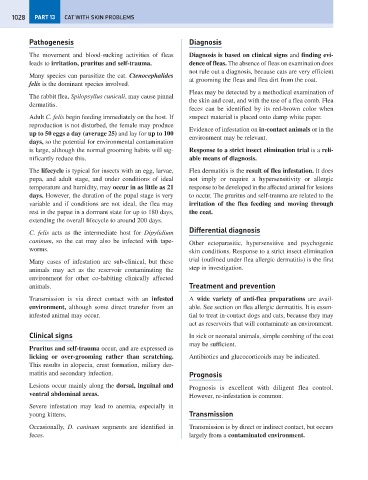Page 1036 - Problem-Based Feline Medicine
P. 1036
1028 PART 13 CAT WITH SKIN PROBLEMS
Pathogenesis Diagnosis
The movement and blood-sucking activities of fleas Diagnosis is based on clinical signs and finding evi-
leads to irritation, pruritus and self-trauma. dence of fleas. The absence of fleas on examination does
not rule out a diagnosis, because cats are very efficient
Many species can parasitize the cat. Ctenocephalides
at grooming the fleas and flea dirt from the coat.
felis is the dominant species involved.
Fleas may be detected by a methodical examination of
The rabbit flea, Spilopsyllus cuniculi, may cause pinnal
the skin and coat, and with the use of a flea comb. Flea
dermatitis.
feces can be identified by its red-brown color when
Adult C. felis begin feeding immediately on the host. If suspect material is placed onto damp white paper.
reproduction is not disturbed, the female may produce
Evidence of infestation on in-contact animals or in the
up to 50 eggs a day (average 25) and lay for up to 100
environment may be relevant.
days, so the potential for environmental contamination
is large, although the normal grooming habits will sig- Response to a strict insect elimination trial is a reli-
nificantly reduce this. able means of diagnosis.
The lifecycle is typical for insects with an egg, larvae, Flea dermatitis is the result of flea infestation. It does
pupa, and adult stage, and under conditions of ideal not imply or require a hypersensitivity or allergic
temperature and humidity, may occur in as little as 21 response to be developed in the affected animal for lesions
days. However, the duration of the pupal stage is very to occur. The pruritus and self-trauma are related to the
variable and if conditions are not ideal, the flea may irritation of the flea feeding and moving through
rest in the pupae in a dormant state for up to 180 days, the coat.
extending the overall lifecycle to around 200 days.
C. felis acts as the intermediate host for Dipylidium Differential diagnosis
caninum, so the cat may also be infected with tape- Other ectoparasitic, hypersensitive and psychogenic
worms. skin conditions. Response to a strict insect elimination
Many cases of infestation are sub-clinical, but these trial (outlined under flea allergic dermatitis) is the first
animals may act as the reservoir contaminating the step in investigation.
environment for other co-habiting clinically affected
animals. Treatment and prevention
Transmission is via direct contact with an infested A wide variety of anti-flea preparations are avail-
environment, although some direct transfer from an able. See section on flea allergic dermatitis. It is essen-
infested animal may occur. tial to treat in-contact dogs and cats, because they may
act as reservoirs that will contaminate an environment.
Clinical signs In sick or neonatal animals, simple combing of the coat
may be sufficient.
Pruritus and self-trauma occur, and are expressed as
licking or over-grooming rather than scratching. Antibiotics and glucocorticoids may be indicated.
This results in alopecia, crust formation, miliary der-
matitis and secondary infection. Prognosis
Lesions occur mainly along the dorsal, inguinal and Prognosis is excellent with diligent flea control.
ventral abdominal areas. However, re-infestation is common.
Severe infestation may lead to anemia, especially in
young kittens. Transmission
Occasionally, D. caninum segments are identified in Transmission is by direct or indirect contact, but occurs
feces. largely from a contaminated environment.

